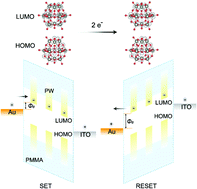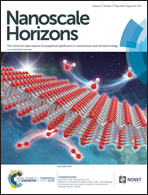Keggin-type polyoxometalate cluster as an active component for redox-based nonvolatile memory†
Abstract
Redox-based nonvolatile memory, where the nanoscale redox process is generally conceived to account for resistance change in external electrical stimuli, is attracting much scientific interest because of its high potential for application in next-generation memory and neuromorphic computing systems. However, materials used in current redox-based resistive switching memory are usually restricted by bulk transition metal oxides. Polyoxometalates (POMs)—a class of discrete early transition metal oxide molecular clusters—are gaining popularity in emerging applications of molecular electronic devices owing to their nanoscale size, high stability, and rich reversible redox potential. This paper reports nonvolatile memory associated with the redox behavior of POMs. Resistive switching mechanisms of POM-based resistive switching memory were systematically investigated for the first time. The intrinsic redox property of POMs was confirmed to initiate the formation of conductive filaments, which are developed by the migration of oxygen ions, as verified through electron energy loss spectroscopy. The results of this study could provide valuable insight into application of redox molecular-based memory for high-density data storage.

- This article is part of the themed collection: Horizons Community Board Collection: Advanced Memory Technologies


 Please wait while we load your content...
Please wait while we load your content...